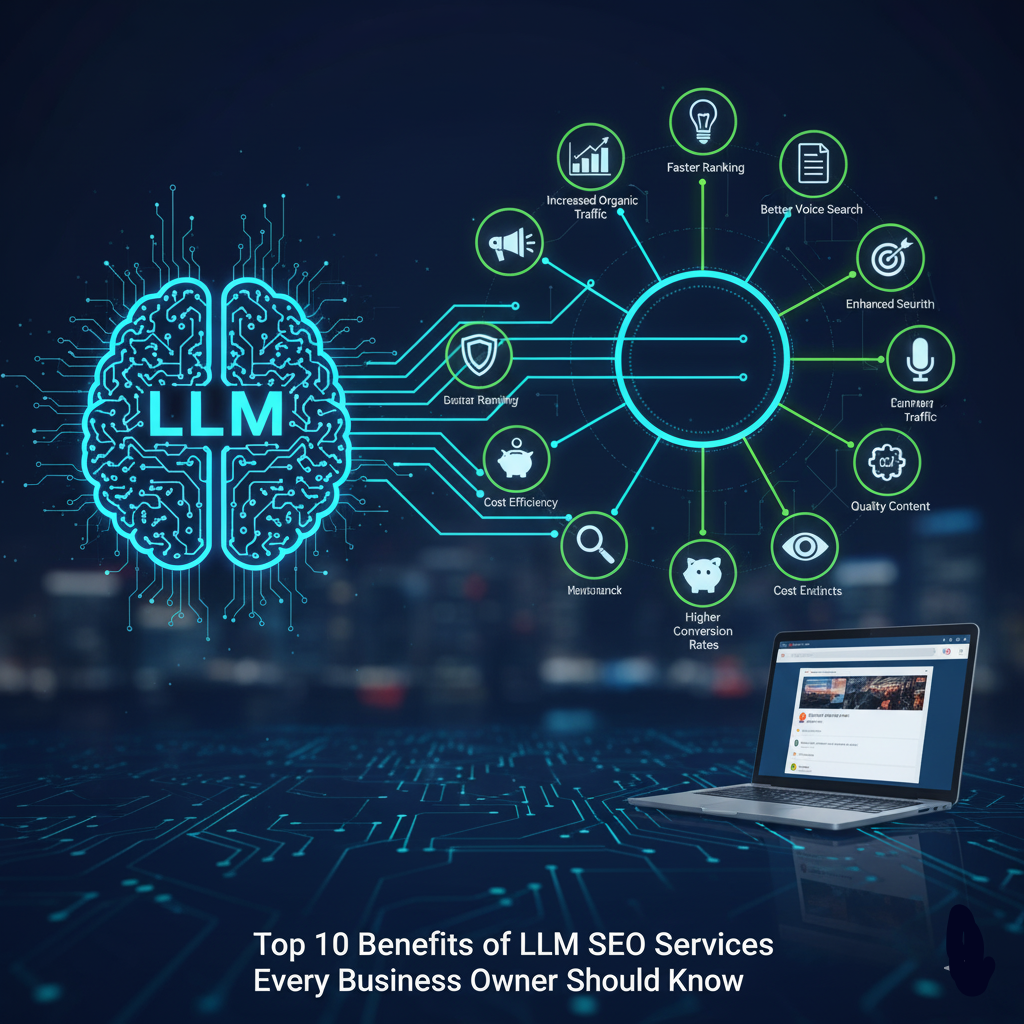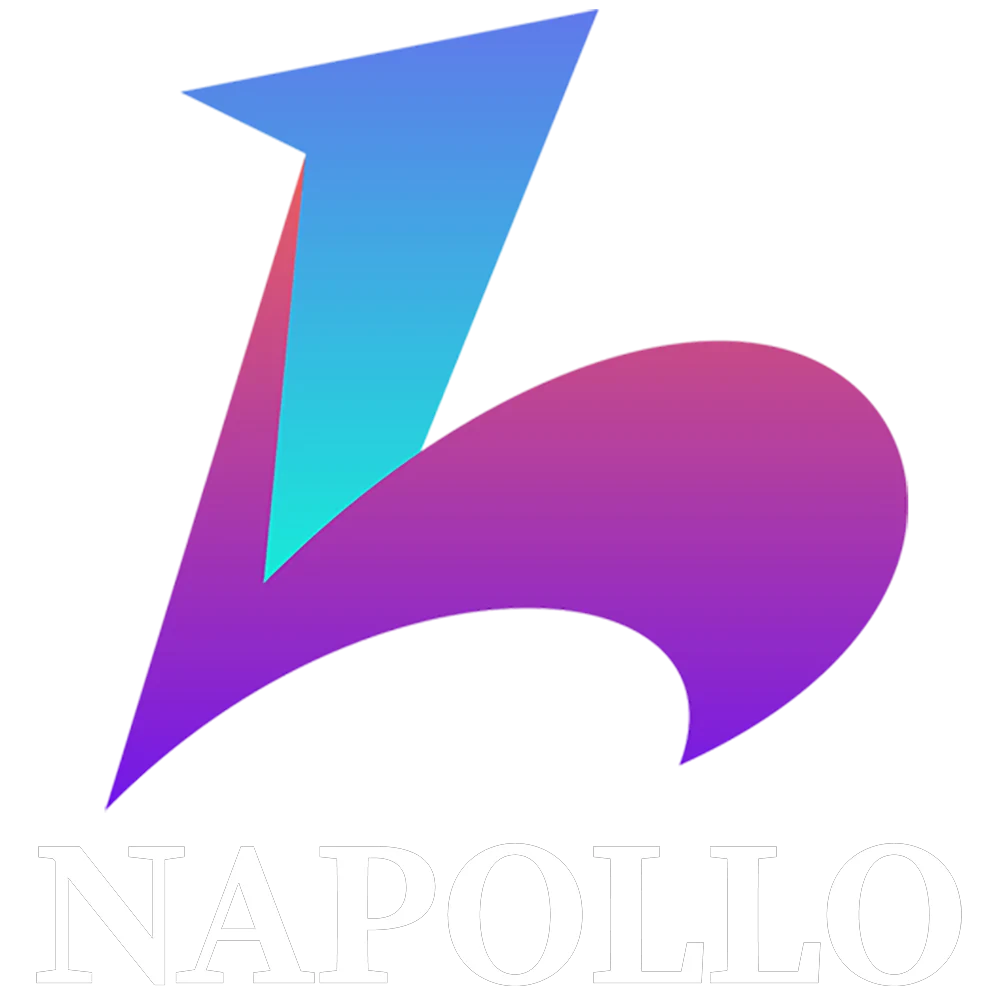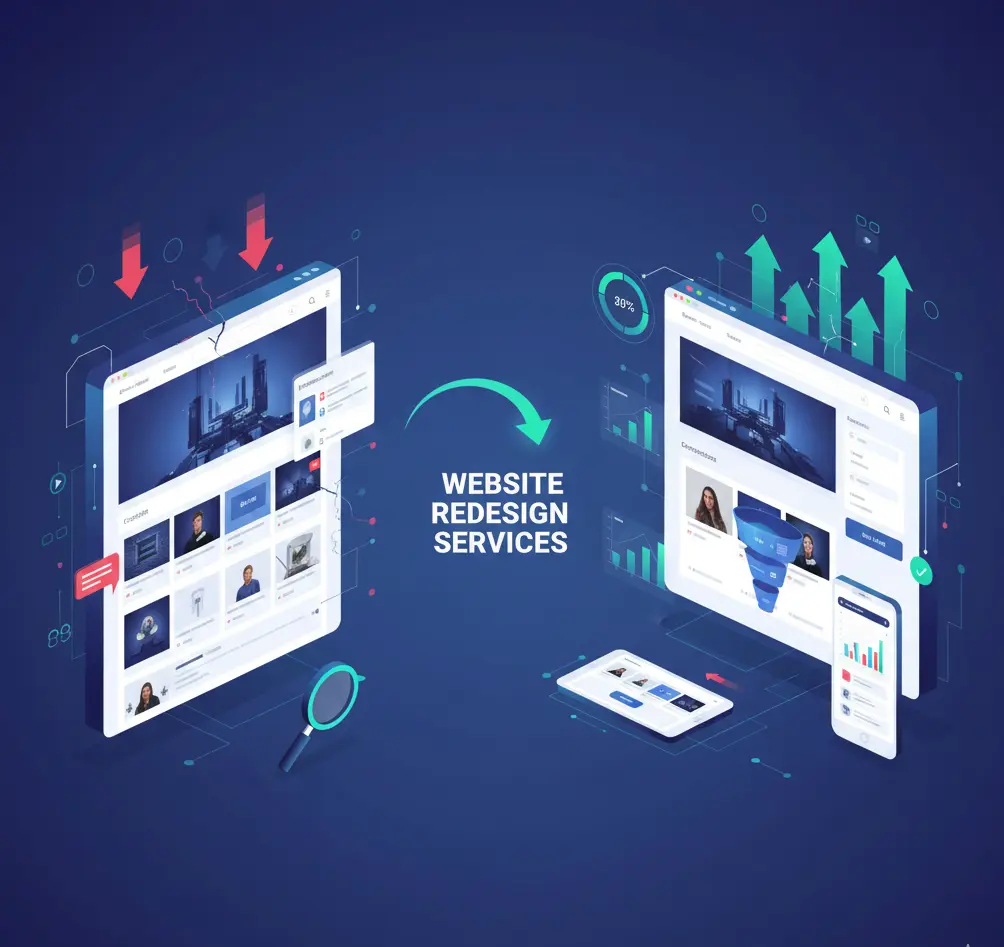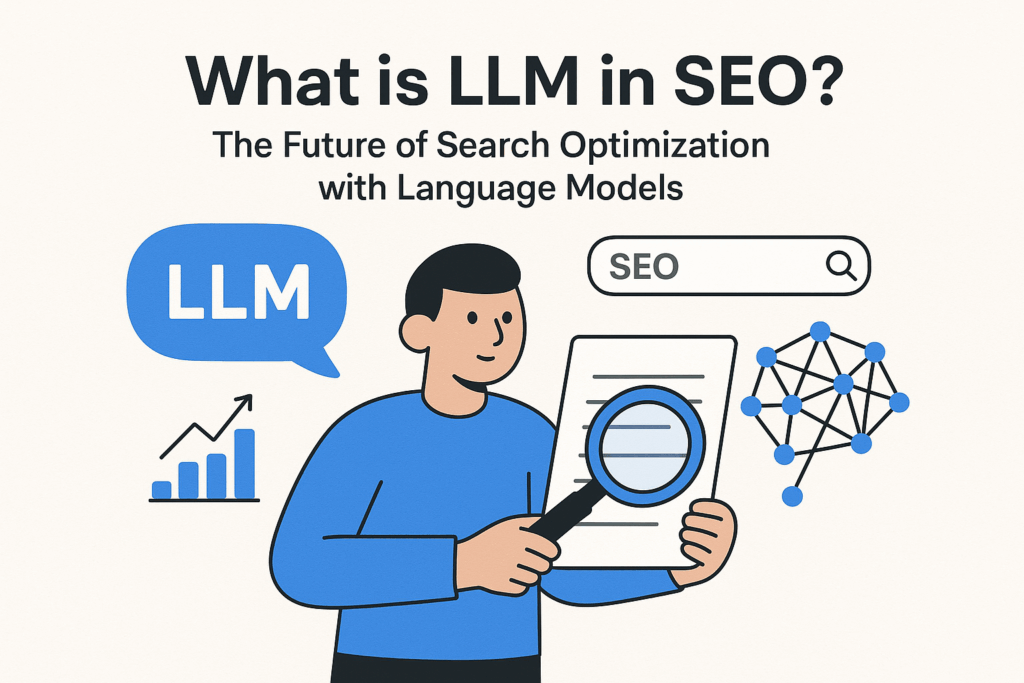Contents
- 1 What LLM SEO Services Mean Today
- 1.1 1. Precise Intent Matching Through Semantic Search
- 1.2 2. Responsible Content Scalability Without Quality Loss
- 1.3 3. Faster, Better Research With Data Driven Optimization
- 1.4 4. On Page Quality At Template Speed
- 1.5 5. Higher Eligibility For Featured Snippets And Voice Answers
- 1.6 6. Smarter Coverage Of Long Tail And Emerging Topics
- 1.7 7. Personalization By Use Case, Industry, And Location
- 1.8 8. Feedback Loops That Improve Over Time
- 1.9 9. Safer, Faster Production Of AI Generated Content
- 1.10 10. Future Proofing SEO In A Rapidly Changing Landscape
- 2 How LLM SEO Fits With Core SEO Strategy
- 3 Where LLM SEO Shines In Different Models
- 4 Technical Signals That Support LLM Aware Content
- 5 Risk Controls And Governance
- 6 Practical Tips For Getting Started
- 7 Conclusion
- 8 FAQs
Search is changing fast as users move from short keywords to natural questions and conversational tasks. Traditional tactics still matter, but the winners in search now pair fundamentals with intelligence from large language models. This is where LLM SEO services come in. By combining natural language processing (NLP), structured workflows, and strong editorial judgment, LLM driven programs make your visibility more resilient and your operations more efficient. Below is a clear and practical guide to the ten benefits you can expect when you add LLM capabilities to your SEO strategy in modern digital marketing.
What LLM SEO Services Mean Today
At their core, LLM SEO services apply LLM SEO techniques to research, plan, create, and improve content that aligns with searcher intent. The program uses AI-driven SEO to discover topics, cluster terms, and shape outlines that fit how people really ask questions. It also supports writers with high quality drafts that editors refine, and it gives engineers structured recommendations for internal links and template improvements. The result is a workflow that protects quality while gaining speed and scale.
1. Precise Intent Matching Through Semantic Search
Modern discovery is built on meaning rather than exact matches. LLM systems learn how queries, entities, and concepts relate. When you apply them correctly, you map content to intent more reliably and cover a topic from multiple angles. This produces pages that answer the real question behind the query and it improves eligibility for featured snippets because explanations are clearer, shorter, and better structured. As semantic search keeps improving, LLM support helps your library stay aligned with how people and engines interpret context.
Why this matters to owners. Better intent alignment means more qualified traffic, fewer bounces, and conversion paths that feel natural. You are not just chasing keywords. You are meeting users where they are.
2. Responsible Content Scalability Without Quality Loss
Many teams need more pages than a small staff can produce by hand. LLMs enable content scalability while keeping standards high. The model can generate first drafts for long form guides, category intros, FAQs, and glossary entries. Editors then fact check, localize examples, and add brand voice. Designers and developers apply pattern libraries so each asset renders cleanly across devices. When you control prompts, check facts, and enforce style rules, scalability does not mean thin content. It becomes a reliable way to expand coverage while protecting quality.
3. Faster, Better Research With Data Driven Optimization
Good research takes time. LLM SEO services accelerate discovery by analyzing topics, identifying gaps, and suggesting angle ideas that competitors miss. Combined with analytics and search console data, the program supports data-driven optimization that targets the pages and modules that will move results first. Teams can evaluate internal links, heading structure, and content depth at scale, then prioritize updates that affect revenue. This turns research into quick, confident action rather than long, uncertain cycles.
4. On Page Quality At Template Speed
Foundational on-page SEO still matters. Titles guide clicks. Headings guide readers. Descriptions shape expectations. LLM assisted workflows generate draft meta descriptions that copywriters refine. They propose alt text optimization for images that improves accessibility and context. They recommend internal anchors that connect related articles and categories without stuffing keywords. When templates and prompts are well designed, these improvements arrive quickly and consistently across the site.
5. Higher Eligibility For Featured Snippets And Voice Answers
Clear definitions, step lists, comparison tables, and short answers help your pages earn visibility in SERP features. LLMs suggest concise formulations that match how snippets and assistants select responses. That same structure supports voice search optimization because conversational agents prefer direct, natural wording. When you combine these assets with supporting sections that cover depth and nuance, you can win attention for both short answers and detailed follow up.
6. Smarter Coverage Of Long Tail And Emerging Topics
LLMs are very good at finding related concepts and questions. They help you group long-tail keywords into clusters that deserve their own sections or pages. They also surface new subtopics that move quickly in your niche. Editors then choose where to add paragraphs, where to publish new posts, and where to combine near duplicates. Done with judgment, this approach increases breadth while keeping quality high. It also helps emerging products, features, or policies rank faster because your content strategy adapts before competitors.
7. Personalization By Use Case, Industry, And Location
Searchers want examples that match their situation. With the right guardrails, LLMs produce variations that support a personalized SEO strategy without duplicating content. For commerce, that might mean distinct angles for ecommerce SEO product guides. For local businesses, structured blocks can support local SEO with relevant service areas and common questions. For software, documentation and comparisons can serve SaaS SEO needs with specific use cases and integration notes. Each variation remains unique because it focuses on user tasks and evidence.
8. Feedback Loops That Improve Over Time
The best programs do not set and forget. They learn. Machine learning feedback loops connect performance data back to prompts, templates, and prioritization. Pages that fall short feed training examples. Sections that earn links become models for future posts. Teams expand successful patterns and retire weaker ones. This rhythm turns AI-powered marketing into a durable operating system rather than a one time experiment.
9. Safer, Faster Production Of AI Generated Content
Quality is non-negotiable. LLMs can draft, but humans must verify. A good workflow identifies which assets can use AI-generated content and which need purely human authorship. It requires editors to check facts, add data, and cite sources where appropriate. It defines where legal or compliance teams must review. With these controls in place, you gain speed without risking brand trust. Your writers spend more time on analysis and less on repetitive setup.
10. Future Proofing SEO In A Rapidly Changing Landscape
Search is moving toward synthesis. Engines and assistants summarize answers and route users to the best resource. LLM SEO services keep your library prepared by structuring content clearly, answering real tasks, and supporting conversational follow up. This is practical future-proofing SEO. Your content stays eligible for new result types, and your brand remains useful regardless of interface. The approach also integrates with paid channels, because strong landing pages help campaigns perform better at lower cost.
For more insight explore this complete guide on What is LLM in SEO? The Future of Search Optimization with Language Models.
How LLM SEO Fits With Core SEO Strategy
LLMs are not a replacement for basics. They make the basics more effective. A strong program still uses a durable SEO strategy that covers crawl efficiency, internal links, accessibility, and performance. It still tracks how real users engage, and it still improves copy, layouts, and schemas over time. LLM assistance simply reduces friction and reveals better options faster.

Research and planning
Start with a clear brief. Identify the audience, the problem to solve, and the desired action. Use LLM powered clustering to group topics, then map them to pages and sections. Align with business goals before writing a single line.
Creation and review
Generate outlines and drafts with guidance, then have editors refine tone and structure. Add facts, examples, and brand voice. Ensure the article answers the original task and provides helpful follow up.
Enhancement and structure
Add supporting modules such as comparison tables, FAQs, and how to sequences. Include internal links to relevant resources. Provide concise descriptions for images. Keep accessibility and readability in mind.
Measurement and iteration
Monitor rankings, traffic quality, and conversions. Identify sections to expand or combine. Confirm that changes improve results. Feed learning back into prompts and templates so your process keeps improving.
Where LLM SEO Shines In Different Models
LLM assistance works across business models because it focuses on intent and clarity.
Commerce: Category intros become more helpful. Product comparisons address real questions. Buying guides include practical steps. For ecommerce SEO, this means searchers find the right product faster and are more likely to purchase.
Local: Service pages emphasize outcomes, availability, and trust. Location content addresses regulations and typical timelines. For local SEO, this means more bookings and better quality leads.
SaaS: Documentation is clearer, and problem statements reflect customer language. Feature pages explain trade offs and integrations. For SaaS SEO, this means prospects evaluate faster and reach sales with fewer gaps.
Technical Signals That Support LLM Aware Content
Pages still need to load quickly and communicate structure clearly. Keep Core Web Vitals healthy. Ensure clean internal links and predictable heading hierarchies. Provide descriptive sitemap entries and maintain accurate canonical signals. A good technical foundation helps engines understand and trust your content.
Risk Controls And Governance
Set boundaries for where LLMs can assist and where human authorship is required. Maintain logs of prompts and changes. Give editors final control over publishing. Define a process for updates when products, prices, or policies change. Governance prevents mistakes and builds internal trust.
Practical Tips For Getting Started
Begin with one cluster that matters to the business. Define the user’s job to be done. Draft a handful of briefs with LLM support. Publish a small set of pages with strong structure and examples. Measure results, then expand. Keep investigators, editors, designers, and developers in the loop so quality is shared and wins are repeatable.
Conclusion
If you want to apply LLM SEO services in a way that is safe, useful, and measurable, choose a partner that treats intelligence as part of the operating model rather than a shortcut. The right team will combine AI-driven SEO, clear editorial standards, and disciplined measurement to produce helpful pages that rank and convert.
They will support structured work across research, creation, improvement, and testing, and they will align with your commercial goals. If you prefer a provider that delivers this approach through mature workflows, governance, and integrated services across planning, content, and performance, Napollo can help you implement LLM capabilities that strengthen your SEO strategy and expand what your team can achieve.
FAQs
1. Which LLM is best for SEO?
The best large language model is the one that fits your workflow, governance, and budget. Evaluate output quality, customization options, safety controls, and integration with your CMS and analytics. Pilot two models on the same briefs, then pick based on measurable performance.
2. What are the benefits of using LLMs for SEO?
LLMs speed research, cluster topics, draft outlines, and suggest internal links. They help align content with searcher intent, improve consistency in meta descriptions and alt text, and surface long-tail opportunities. With human editing and clear rules, teams scale quality without sacrificing accuracy.
3. What are the benefits of AI for SEO?
AI accelerates keyword clustering, content briefs, and competitive gap analysis. It suggests schema, snippet-friendly structures, and on-page improvements. Used responsibly, AI reduces repetitive tasks so strategists and editors spend more time on research, examples, and differentiation that actually moves rankings and conversions.
4. Why is SEO important for business?
SEO connects your products and expertise to people actively searching. It compounds over time, lowering acquisition costs, strengthening credibility, and capturing demand across the funnel. When paired with strong user experience and measurement, organic visibility drives qualified traffic and sustainable revenue growth.
5. Where to start SEO optimization for a small business?
Start with fast mobile pages, simple navigation, and accurate local listings. Publish helpful answers to common questions, add reviews and clear service pages, and ensure consistent NAP data. Track calls, forms, and bookings. Improve what works, and expand gradually with focused content.






